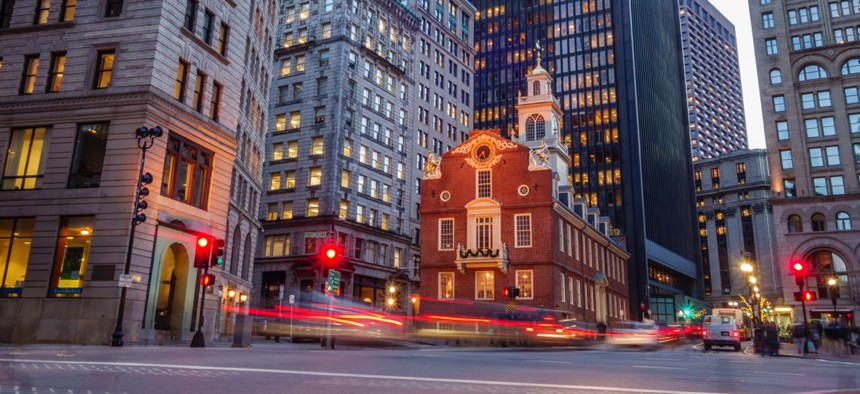New Rankings Show That This State Bests All Others; Sessions Will Ease Federal Police Dept. Monitoring

The historic Old State House in Boston, Massachusetts.

Connecting state and local government leaders
Also in our State and Local Daily Digest: N.C. governor releases spending plan; Oklahoma’s earthquake risk in 2017; and was a Michigan city built with Confederate gold?
STATE RANKINGS | Massachusetts is the best state in the union, according to U.S. News & World Report’s annual ranking, followed by New Hampshire, Minnesota, North Dakota and Washington. The Bay State topped the chart by ranking first for education, second for health care—the two most heavily weighted categories—and fifth for economy. Other categories U.S. News considered were infrastructure, crime and corrections, opportunity and government. Indiana placed first for best government because of its high budget transparency, digitalization and fiscal stability. The worst state overall? Louisiana. [U.S. News & World Report]
POLICE | U.S. Attorney General Jeff Sessions said the Justice Department would ease monitoring of police departments, so as to “not diminish their effectiveness,” addressing the National Association of Attorneys General. He hinted he felt the Obama administration's investigations into civil rights abuses among law enforcement had undermined respect for police agencies in cities he avoided naming. “So we’re going to try to pull back on this, and I don’t think it’s wrong or mean or insensitive to civil rights or human rights,” Sessions said. [The New York Times]
EMERGENCY PREPAREDNESS | The U.S. Geological Survey reports that there’s a 10 to 12 percent chance that areas of central Oklahoma, which have seen a spike in seismic activity in recent years, will experience a damaging earthquake in 2017. That risk is down slightly over 2016. “Millions still face a significant chance of experiencing damaging earthquakes, and this could increase or decrease with industry practices, which are difficult to anticipate,” according to Mark Peterson, the chief of the USGS hazard mapping project. [The Tulsa World]
OVERSIGHT | Rappahannock County government has failed to follow proper expense and payroll procedures, due to a lack of oversight by officials, according to the Virginia county’s Treasurer Debbie Knick. In her criticisms to county supervisors, Knick has targeted the county administrator of eight months, Debbie Keyser, for falsely blaming their computer system for improper disclosure of credit card purchases. Overpayment of employees is also an issue. [RappNews]
RELIGION | In a conversation with state attorneys general following vandalism at a Philadelphia-area Jewish cemetery, President Trump appeared to suggest that the recent rash of threats against similar sites may actually be a false flag attempt to “make others look bad,” according to Pennsylvania Attorney General Josh Shapiro. "Myself and many other [attorneys general] of both parties were a little bit surprised," Shapiro said. [Philly.com]
STATE BUDGETS | North Carolina Gov. Roy Cooper unveiled his $23.8 billion state spending plan on Wednesday, calling it “a fiscally responsible budget with investment in our future without raising taxes, without raising fees, without cutting services and without dipping into special funds.” [@NCCapitol / WRAL-TV]
TRANSPORTATION | What happened to a plan previously championed by New York City Mayor Bill de Blasio to build a new subway line in an underserved area of Brooklyn? Not much. A request to study a possible subway line along Utica Avenue was “open ended” and never had a champion to push it. [Second Avenue Sagas]
PHILANTHROPY | Charles Hackley has been dead for more than a century, but the influential lumber baron and philanthropist who built many of the civic institutions in Muskegon, Michigan, is in the news again. Hackley, according to researchers, may have boosted his fortune with the help of missing Confederate gold from the Civil War. Historians have their doubt, calling the theory “far-fetched.” [Muskegon Chronicle / MLive.com]
WILDLIFE | Billboards urging people to call Montana Gov. Steve Bullock to tell him to “Stop the Yellowstone Massacre” are appearing in protest of the annual shipping of Yellowstone bison to slaughter. Environmental groups oppose killings. The culling of the bison herd is part of a management plan that is aimed at preventing the disease brucellosis, which can cause the animals to abort their calves. The plan calls for a population of about 3,000 bison in Yellowstone. About 5,500 bison live there now. [Bozeman Daily Chronicle]

NEXT STORY: Locked Up: Is Cash Bail on the Way Out?




